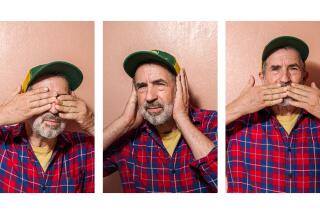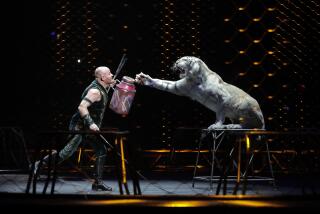A High-Wire Naturalist With a Lens
He was the Evel Knievel of the natural world, tempting death by wrestling man-eating crocodiles or galloping into the Australian outback to commune with deadly snakes. So when the end came Monday for Steve Irwin, television’s “Crocodile Hunter,” it was surprising and swift: The 44-year-old was pierced in the heart by the usually placid stingray.
Footage of the incident in a Great Barrier Reef lagoon off the coast of northeastern Australia shows Irwin swimming alongside a large, smooth stingray in less than 7 feet of water while a cameraman maneuvers in front to film him for a new television series.
Without warning, the ray speared Irwin in the chest, lodging a poisonous barb at the end of its tail in his heart.
Experts described Irwin’s death as a “one-in-a-million occurrence,” a freak accident that may have happened because the stingray felt cornered.
Dr. Ed O’Loughlin, who tried to save him, called the death “highly unusual” and said Irwin appeared to have suffered a “form of cardiac arrest,” Australian media reported. An autopsy was planned.
John Howard, Australia’s prime minister, said he was “shocked and distressed” by Irwin’s death and seemed to echo the sentiments of a country when he said Australia had lost a “wonderful and colorful son.”
Australians were stunned by Irwin’s death, and many called for a state funeral to acknowledge his contributions to tourism and conservation. Government officials said they needed to speak with Irwin’s family before making any decisions.
Mourners continued to lay flowers and light candles at the gates of Irwin’s Australia Zoo, which Irwin’s family founded as a small wildlife park on the Queensland coast in 1970.
“We’re all very shocked. I don’t know what the zoo will do without him. He’s done so much for us, the environment, and it’s a big loss,” Paula Kelley, a zoo volunteer, told the Associated Press as she dropped off a wreath at the gate.
When they weren’t being taken down by unusually high traffic, Internet message boards dedicated to Irwin overflowed with postings like this one on cnn.com: “Stevie, mate, you’re a legend here in ‘stralia. You will forever be missed.”
British zoologist Mark O’Shea told the BBC that Irwin’s death was an immense loss to the worlds of both conservation and television, adding that Irwin had paved the way for others to work in those fields.
Irwin’s series, “The Crocodile Hunter” -- which has been described as “Wild Kingdom” meets “Mad Max” -- was first broadcast in Australia.
At its peak, the show aired in more than 200 countries and became an important building block in the success of Animal Planet, which had aired the series since the cable channel’s inception in 1996.
Irwin’s documentaries regularly featured him wearing his trademark khaki shorts and often wildly gesturing while leaping onto the backs of huge crocodiles and exclaiming “Crikey!” -- the Aussie version of “gee whiz!” The documentaries debuted on the Discovery Network in 1992.
Irwin’s fervid, informal style, even as he worked with often dangerous animals, “influenced everything we do at the network,” Maureen Smith, executive vice president and general manager of Animal Planet, a Discovery Communications cable channel, told The Times on Monday.
Smith recalled being at a hotel in New York City with Irwin recently when a group of strangers gave him a standing ovation.
The show “really became a part of pop culture,” she said.
On television, Irwin was spoofed on “South Park” for his penchant for uttering such phrases as “Check out the size of this bloke!” He made a cameo appearance in the 2001 Eddie Murphy film “Dr. Dolittle 2,” in which he attempts to wrestle an alligator and loses an arm. He took his act to the big screen a year later in the feature film “The Crocodile Hunter: Collision Course.”
But by being parodied on “The Simpsons,” Irwin had cemented his place in America’s pop culture pantheon, said Robert J. Thompson, director of the Center for the Study of Popular Television at Syracuse University.
“ ‘The Crocodile Hunter’ was to Animal Planet what ‘South Park’ was to Comedy Central. Every cable channel needs one of those defining shows,” Thompson said.
Though Irwin was hugely popular in Australia -- when Howard invited him to a lunch honoring President Bush in 2003, he showed up in his trademark khakis -- his public image suffered in early 2004 when he held his month-old son near the mouth of a crocodile he was hand-feeding. Child-welfare advocates said he had endangered his son, but Irwin was not charged with any offense.
What he would do differently the next time, Irwin said, was “make sure there were no cameras around.”
Later that year, Irwin was accused of getting too close to a penguin, a seal and humpback whales in Antarctica while making a documentary. Irwin denied any wrongdoing, and an Australian Environment Department investigation recommended no action be taken against him.
The naturalist blamed the accusations on a “huge vendetta” by the anti-conservation lobby. In addition to regularly speaking out for conservation on “The Tonight Show With Jay Leno” and in other forums, he established a conservation center near St. George, Australia, and often used his own money to preserve wildlife habitats.
Stephen Robert Irwin was born Feb. 22, 1962, near Melbourne, Australia, to Bob, a plumber, and Lyn, a nurse. For his sixth birthday, he received a 12-foot-long scrub python.
Growing up at the wildlife park his parents founded, Irwin reportedly learned at age 9 to catch crocodiles in the rivers of North Queensland. He became a crocodile trapper in 1980, removing the reptiles from populated areas without charge as long as he was allowed to keep them for his family’s park.
When Irwin took over the park in 1991, he renamed it the Australia Zoo. The once-struggling enterprise employed 500 people and had become one of Australia’s main tourism draws.
That same year he met and soon married Oregon-born Terri Raines. Their unconventional honeymoon spent trapping crocodiles in the wild -- documented by a four-person film crew -- was made into two documentaries. One became the first episode of “The Crocodile Hunter,” launching Irwin’s television career.
On Monday, Irwin was working on a documentary called “Ocean’s Deadliest” when he paused to gather footage of the stingray for an Animal Planet special to be hosted by his 8-year-old daughter, Bindi Sue. In addition to his wife and daughter, Irwin is survived by his 2-year-old son, Bob.
Though Irwin saw himself as a wildlife educator, some critics viewed his risky behavior as a high-wire act with a camera as the center ring.
Former Times television critic Howard Rosenberg criticized Irwin in 2003 for exploiting animals on his shows.
“Although Steve Irwin is among the more benign offenders, it’s still hard reconciling his self-proclaimed role as wildlife protector (based at the Australia Zoo in Queensland) with his television behavior as a daredevil buffoon who uses animals as props,” Rosenberg wrote.
When asked how he would respond to those who don’t like the way he treated animals, Irwin had a ready defense.
“Here we are in the year 2003 and people are wondering whether I am bothering the chameleons or bothering a crocodile,” he told The Times. “Isn’t that fantastic? Ten years ago, mate, people would go, ‘That’s just a slimy, stinky reptile.’ Haven’t we changed?”
*
Times staff writers Kate Aurthur and Sallie Hofmeister contributed to this report.
More to Read
Sign up for Essential California
The most important California stories and recommendations in your inbox every morning.
You may occasionally receive promotional content from the Los Angeles Times.











